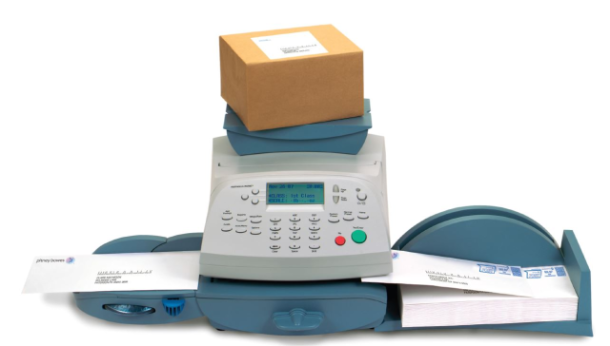Postage Meters Guide
Postage meters help businesses and organizations to reduce operating costs and save time by streamlining mail-related administrative functions. When thinking of postage meters, many people envision large mailrooms sorting massive amounts mail. But, postage meters are valuable for small businesses that send small amounts of daily mail and packages or occasional bulk mail. Here’s what you need to know to make an informed decision before acquiring a postage meter.
What is a postage meter?
A postage meter is a machine that prints postage onto envelopes, packages, or labels. Businesses use postage meters instead of stamps to save time and money.
- You can use the machine to affix postage to envelopes, packages, postcards, and other types of mailers. The postage can be applied directly to the item or printed on a label that is placed on the item. Postcards and envelopes are most likely to have the imprint directly on the item, while packages usually have a postage label. {' '}
- The postage machine uses an imprint, known as the indicia or frank, which includes the dollar amount of the postage applied, a dated postmark, and a cancellation. The imprint or franking includes a barcode with the mail sender’s identification to prevent the use of counterfeit postage.
How do I obtain a postage meter for my business or organization?
You can rent or lease a postage meter from an authorized equipment vendor. Some dealers offer both new and used equipment. The United States Postal Service, USPS, that regulated the printing of postage, owns the actual meter while the equipment vendor owns the machine that houses the meter.
How do postage meters work?
First, you must fill your machine with the actual postage to be used. There are different ways to add money to your postage meter account including ACH, direct debit, or through a USPS account. You can also choose how and when to refill your machine, either by adding a fixed amount at regular intervals or when your postage balance reaches a certain level. {' '}
Next, you’re ready to weigh the item and calculate the postage. The scale, which may be attached to the meter or a separate piece of equipment, includes a screen and buttons or a touchscreen where you can select the class and mailing options like registered or priority mail. {' '}
After you enter the amount and type of postage needed, you’ll run the envelope or label through a manual or automatic feeder. The item will be stamped with the postage and is ready to be mailed. {' '}
What are the features of a postage meter?
The two most important features of every postage machine are the scale and built-in security features.
- The scale is included so that users can weigh an item to calculate the amount of postage that’s required. This allows you to save money by applying the exact amount of postage rather than using extra stamps.
- Security features include user PIN numbers, department codes, or project and cost-center codes. These allow you to eliminate unauthorized use of your postage meter as well as track and monitor use by individuals and departments.
The other components found on every postage machine are the base, the meter, a display screen, and a feeder.
- The meter stores and calculates the postage.
- The meter creates the imprint or franking.
- The display screen provides user instructions, shows the balance in your postage account, and displays status or error messages
- Manual feeders require you to put the envelope, card, or label into the imprint area of the machine. Automatic feeders do the work for you.
- Memory buttons which allow you to pre-program and store items like billing or department codes.
- Shortcut keys allow you to automate frequent mailing tasks, such as registered mail or shipping labels with postage affixed.
- A sealer can save you time by moistening and closing envelopes as they go through the feeder.
What if I need a high-volume postage machine for my mailroom?
If you do large amounts of bulk mailing, consider leasing a larger mailing machine with a full keyboard and monitor or a touchscreen monitor; conveyers to stack, sort, and organize your mail; and catch trays to hold large amounts of mail. {' '}
Compare Postage Meter Vendors and Costs
There are four primary postage meter vendors in the United States. Here’s an overview of each company, their products and services, and their prices.
- Data-Pac - Turn your computer into a mail and postage system along with offering small meters and heavy-duty postage machines. PC solutions start at $15 per month while meter rentals range from $20 to $1,000 per month.
- Hasler - Hasler offers low-volume postage meters from $15 to 25 per month; mid-volume with advanced features and higher capacity at $35 to $250; and high-volume mailroom machines priced from $200 to $550 per month.
- Neopost - The second largest postage supplier worldwide offers solutions for shipping like address printers, inserters, and sorters. Their low-volume machines include tracking features with sorters that handle 40 items per minute, starting at $150 to $500 for a yearly rental. Mid-volume machines rent at up to $1,500 yearly. High-volume mailroom machines go for up to $11,000 annually. {' '}
- Pitney Bowes - Pitney Bowes is the largest supplier of mailing and postage equipment. With rental prices ranging from $19.99 to $65.00 per month, they offer the largest number of mail solutions for businesses of any size.
Summary
Select the features that improve your productivity the most. If your business is growing quickly, consider options that you can use down the road. Avoid the bells and whistles that you cannot or will rarely use. Choose the machine that is easiest for you and your employees to use and fits in your budget. {' '}

